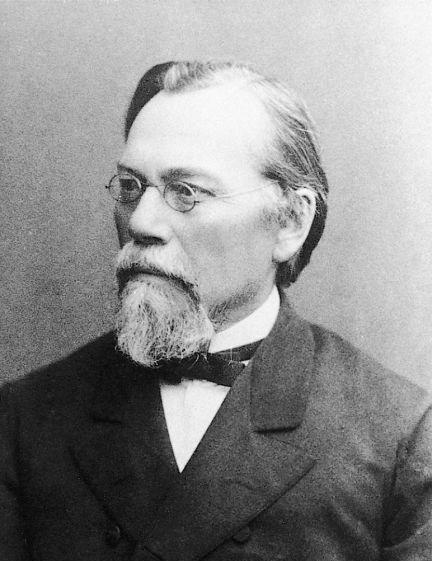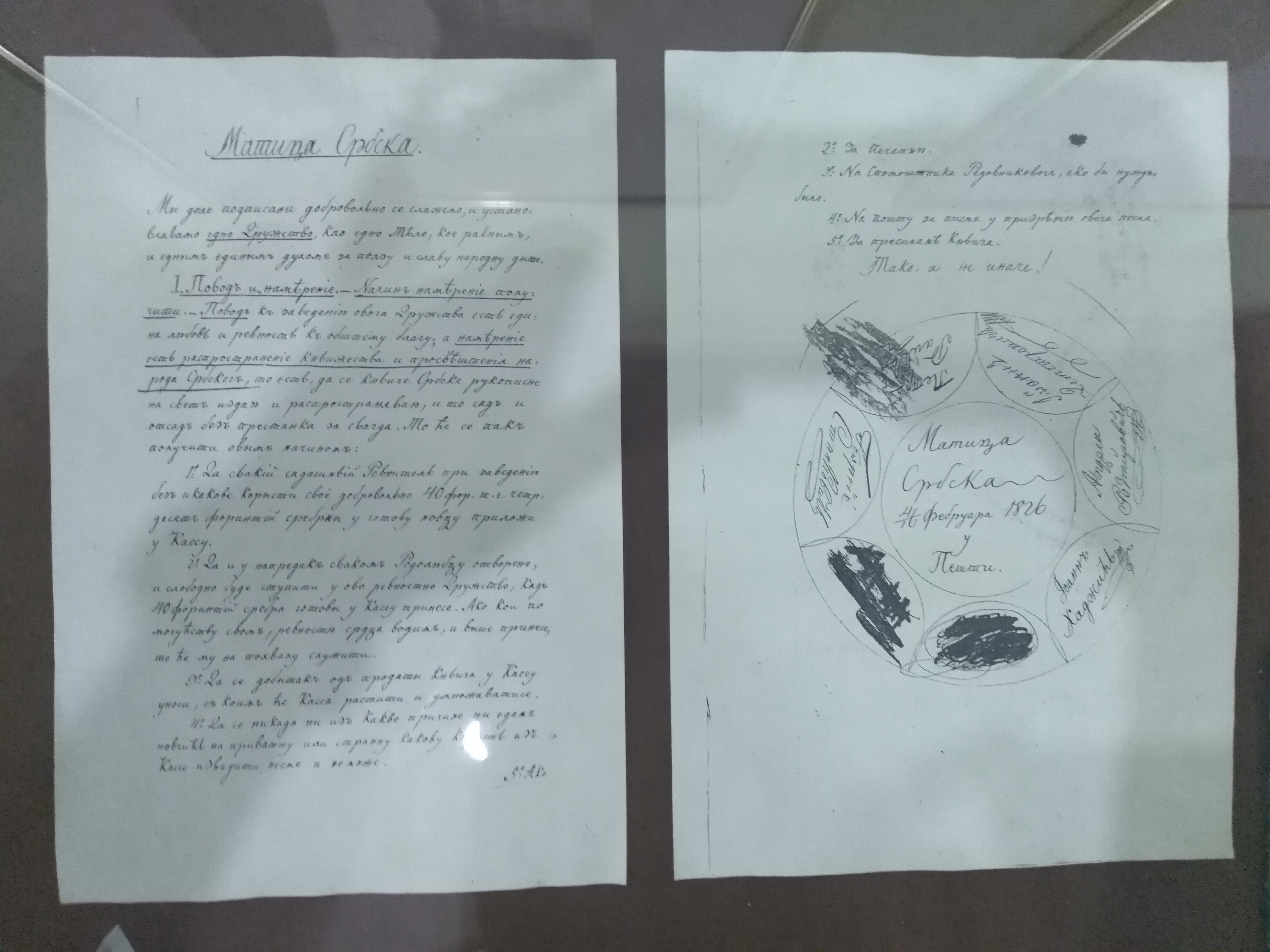|
Aleksa Vukomanović
Aleksa Vukomanović ( Srezojevci, 21 March 1826 – Belgrade, 6 November 1859) was a historian and professor of the Lyceum in Belgrade. Biography He was born on 21 March 1826 in Srezojevci, in the mining district. His father was the brother of Princess Ljubica Vukomanović. When his father died, his aunt Princess Ljubica sent him to Odessa where he attended high school from 1840 to 1844. He fell ill in Odessa and had to return to Serbia for treatment. After that, he returned to Imperial Russia to the University of Kiev, where from 1847 to 1850 he studied historical and philosophical sciences and became a Ph.D. candidate in 1851. In December of that year Prince Miloš Obrenović's decree established one more chair at the Belgrade Lyceum. It was the chair of "The history of the Serbian people and the literature of Serbia". When he returned to Serbia in early 1852, he was appointed professor of Theory of Literacy, The History of the Serbian people and the Literature of Serbia and Lit ... [...More Info...] [...Related Items...] OR: [Wikipedia] [Google] [Baidu] |
Srezojevci
Srezojevci is a village in the municipality of Gornji Milanovac, Serbia. According to the 2002 census, the village has a population of 424 people.Popis stanovništva, domaćinstava i Stanova 2002. Knjiga 1: Nacionalna ili etnička pripadnost po naseljima. Republika Srbija, Republički zavod za statistiku Beograd 2003. Princess consort Ljubica Vukomanović Ljubica Vukomanović ( sr-cyr, Љубица Вукомановић; September 1788 – 26 May 1843) was Princess consort of the Principality of Serbia as the wife of Miloš Obrenović, Prince of Serbia, and the founder of the Obrenović dyn ...-'' Obrenović'' was born in this village in September 1788. References {{commonscat, Srezojevci Populated places in Moravica District ... [...More Info...] [...Related Items...] OR: [Wikipedia] [Google] [Baidu] |
Serbian Academy Of Sciences And Arts
The Serbian Academy of Sciences and Arts (; , SANU) is a national academy and the most prominent academic institution in Serbia, founded in 1841 as Society of Serbian Letters (, DSS). The Academy's membership has included Nobel Prize, Nobel laureates Ivo Andrić, Leopold Ružička, Vladimir Prelog, Glenn T. Seaborg, Mikhail Sholokhov, Aleksandr Solzhenitsyn, and Peter Handke as well as, Josif Pančić, Jovan Cvijić, Branislav Petronijević, Vlaho Bukovac, Mihajlo Pupin, Nikola Tesla, Milutin Milanković, Mihailo Petrović-Alas, Meša Selimović, Mehmed Meša Selimović, Danilo Kiš, Paja Jovanović, Dmitri Mendeleev, Victor Hugo, Leo Tolstoy, Jacob Grimm, Antonín Dvořák, Henry Moore and many other scientists, scholars and artists of Serbian and foreign origin. History Predecessors The Serbian Royal Academy of Sciences () was the successor to the Society of Serbian Literature, Serbian Learned Society () with which it merged in 1892 and accepted its members as its own eith ... [...More Info...] [...Related Items...] OR: [Wikipedia] [Google] [Baidu] |
1826 Births
Events January–March * January 15 – The French newspaper ''Le Figaro'' begins publication in Paris, initially as a satirical weekly. * January 17 – The Ballantyne printing business in Edinburgh (Scotland) crashes, ruining novelist Sir Walter Scott as a principal investor. He undertakes to repay his creditors from his writings. His publisher, Archibald Constable, also fails. * January 18 – In India, the Siege of Bharatpur ends in British victory as Lord Combermere and Michael Childers defeat the princely state of Bharatpur, now part of the Indian state of Rajasthan. * January 30 – The Menai Suspension Bridge, built by engineer Thomas Telford as the first major suspension bridge in world history, is opened between the island of Anglesey and the mainland of Wales. * February 6 – James Fenimore Cooper's novel ''The Last of the Mohicans'' is first printed, by a publisher in Philadelphia. * February 8 – Unitarian Bernardino Rivadavia becomes the first Pr ... [...More Info...] [...Related Items...] OR: [Wikipedia] [Google] [Baidu] |
Matica Srpska
The Matica srpska ( sr-Cyrl-Latn, Матица српска, Matica srpska, ) is the oldest Serbian language independent, non-profit, non-governmental and cultural-scientific Serbian national institution. It was founded on June 1, 1826, in Pest, Hungary, Pest (today a part of Budapest) by the Serbs, Serbian Holy Roman Empire, habsburg legislator Jovan Hadžić and other prominent members of the Serbian Revolution and Serbian Revival, National Revival. The Matica was moved to Novi Sad in 1864. It is the oldest matica in the world. The main goals are to restore and promote Serbian national and cultural identity in the fields of art, science, spiritual creativity, economy and public life as well as to care for social development of Serbia. The literary and cultural society played a huge role in the flourishing of science and culture of the Serbs of Vojvodina, Serbia. The need for national homogenization, enlightenment, as well as the publication of Serbian books, were the main reaso ... [...More Info...] [...Related Items...] OR: [Wikipedia] [Google] [Baidu] |
National Library Of Serbia
The National Library of Serbia () is the national library of Serbia, located in the capital city of Belgrade. It is the biggest library, and oldest institution in Serbia, one that was completely destroyed many times over in the last two centuries. History In 1832, the library was established by bookbinder Gligorije Vozarović in his bookstore, and its first collection consisted of gifts of publisher and bookseller Vozarović and other Serbian cultural figures. On 28 February 1832, Dimitrije Davidović sent a letter on the organization of the library to Miloš Obrenović. In November of the same year, Prince Miloš ordered that one copy of each printed book be made available to the library. During Serbian campaign of World War I, World War I, the Library building and collections were damaged by bombing, so the small remaining holdings were moved from Belgrade to Niš and Kragujevac for their protection. Damages, loses and lack of facilities hampered significantly reconstruction i ... [...More Info...] [...Related Items...] OR: [Wikipedia] [Google] [Baidu] |
Dositej Obradović
Dositej Obradović ( sr-Cyrl, Доситеј Обрадовић, ; 17 February 1739 – 7 April 1811) was a Serbian writer, biographer, diarist, philosopher, pedagogue, educational reformer, linguist and the first minister of education of Serbia. An influential protagonist of the Serbian national and cultural renaissance, he advocated Enlightenment and rationalist ideas, while remaining a Serbian patriot and an adherent of the Serbian Orthodox Church. Life Early life and education Dositej Obradović was born Dimitrije Obradović, probably in 1739, in the Banat village of Čakovo, in the Habsburg monarchy, now Ciacova, in present-day Romania. From an early age, he was possessed with a passion for study. Obradović grew up bilingual (in Serbian and Romanian) and learned classical Greek, Latin, modern Greek, German, English, French, Russian and Italian. On 17 February 1757 he became a monk in the Serb Orthodox monastery of Hopovo, in the Srem region, and acquired ... [...More Info...] [...Related Items...] OR: [Wikipedia] [Google] [Baidu] |
Milan Milićević
Milan Đakov Milićević (; June 4, 1831 – November 17, 1908) was a Serbian writer, biographer, publicist, ethnologist and one of the founders of the Association of Writers of Serbia. Biography He was born of a good and old Serbian family in Ripanj, about 25 kilometers south of Belgrade at the foot of Avala mountain, on the fourth of June 1831. When Milićević was a teenager his parents moved to Belgrade. Having received his early education at the gymnasium of Belgrade (1845), he entered the Grande école (''Velika škola''), and engaged in the study of religion and education. Although Milićević did specially distinguish himself as a student, ill health prevented him from going to Russia to pursue further studies. University life, however, had considerable influence in the development of his character and furnished him with much of his literary material. After taking a degree in 1850, he taught school in the Serbian heartland Lesnik (Serbia), and in 1851 at Topola. In e ... [...More Info...] [...Related Items...] OR: [Wikipedia] [Google] [Baidu] |
Savinac
Savinac ( sr-cyr, Савинац) is an List of Belgrade neighborhoods, urban neighborhood of Belgrade, the capital of Serbia. It is located in Belgrade's municipality of Vračar. Location Savinac is located in the western part of the municipality, on the western slopes of the Vračar hill and stretches from the Slavija Square, Slavija square to the Vračar plateau and the Temple of Saint Sava. The main streets in the neighborhood are ''Svetog Save'', ''Makenzijeva'' and the ''Boulevard of the Liberation''. Originally, the term stretched west of the boulevard (present Karađorđev Park), but today not many people consider that part of Belgrade as part of Vračar. History The neighborhood of Savinac almost entirely overlaps the neighborhood of Englezovac. Construction of the neighborhood began in 1880 when a Scottish people, Scottish businessman and Church of the Nazarene, Nazarene Francis Mackenzie (missionary), Francis Mackenzie bought a large piece of land nearby (which ev ... [...More Info...] [...Related Items...] OR: [Wikipedia] [Google] [Baidu] |
Saint Sava
Saint Sava (, ; Old Church Slavonic: ; Glagolitic: ; ; 1169 or 1174 – 14 January 1235/6), known as the Enlightener or the Illuminator, was a Serbs, Serbian prince and Eastern Orthodox Church, Orthodox monk, abbot of Studenica Monastery, Studenica, the first Archbishop of the autocephalous Serbian Orthodox Church, Serbian Church, writer, great of Serbian law, and a diplomat. Sava, born as Rastko Nemanjić ( sr-Cyrl, Растко Немањић), was the youngest son of Serbian Grand Prince Stefan Nemanja (founder of the Nemanjić dynasty), and ruled the appanage of Zachlumia briefly in 1190–92. He then left for Mount Athos, where he became a monk Tonsure#Eastern Christianity, tonsured with the name ''Sava'' (''Sabbas''). At Athos he established the monastery of Hilandar, which became one of the most important cultural and religious centres of the Serbian people. In 1219 the Ecumenical Patriarchate of Constantinople, Patriarchate exiled in Nicea recognized him as the first Serb ... [...More Info...] [...Related Items...] OR: [Wikipedia] [Google] [Baidu] |
Serbian Orthodox Church
The Serbian Orthodox Church ( sr-Cyrl-Latn, Српска православна црква, Srpska pravoslavna crkva) is one of the autocephalous (ecclesiastically independent) Eastern Orthodoxy, Eastern Orthodox Eastern Orthodox Church#Constituencies, Christian churches. The majority of the population in Serbia, Montenegro and Republika Srpska of Bosnia and Herzegovina are Baptism, baptised members of the Serbian Orthodox Church. It is organized into metropolis (religious jurisdiction), metropolitanates and eparchies, located primarily in Serbia, Bosnia and Herzegovina, Montenegro, and Croatia. Other congregations are located in the Serb diaspora. The Serbian Patriarch serves as first among equals in his church. The current patriarch is Porfirije, Serbian Patriarch, Porfirije, enthroned on 19 February 2021. The Church achieved Autocephaly, autocephalous status in 1219, under the leadership of Saint Sava, becoming the independent Archbishopric of Žiča. Its status was elevated ... [...More Info...] [...Related Items...] OR: [Wikipedia] [Google] [Baidu] |
Tuberculosis
Tuberculosis (TB), also known colloquially as the "white death", or historically as consumption, is a contagious disease usually caused by ''Mycobacterium tuberculosis'' (MTB) bacteria. Tuberculosis generally affects the lungs, but it can also affect other parts of the body. Most infections show no symptoms, in which case it is known as inactive or latent tuberculosis. A small proportion of latent infections progress to active disease that, if left untreated, can be fatal. Typical symptoms of active TB are chronic cough with hemoptysis, blood-containing sputum, mucus, fever, night sweats, and weight loss. Infection of other organs can cause a wide range of symptoms. Tuberculosis is Human-to-human transmission, spread from one person to the next Airborne disease, through the air when people who have active TB in their lungs cough, spit, speak, or sneeze. People with latent TB do not spread the disease. A latent infection is more likely to become active in those with weakened I ... [...More Info...] [...Related Items...] OR: [Wikipedia] [Google] [Baidu] |






